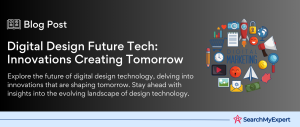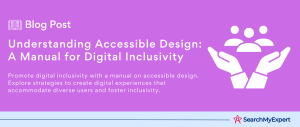Personalization in Digital Design
Embracing Personalization: The New Frontier in Digital Design
In the ever-evolving world of digital design, personalization has emerged as a key player, revolutionizing how users interact with digital platforms. It’s not just about aesthetics; it’s about creating experiences that resonate personally with each user. Personalization, at its core, is the tailoring of a service or product to accommodate specific individuals, often using technology to meet the user’s specific needs and preferences.
Why Personalization Matters
In the digital landscape of today, personalization isn’t just a nice-to-have; it’s a must-have. It’s the difference between a user feeling like just another number and feeling uniquely understood. This tailored approach in digital design has profound implications:
- Enhanced User Experience: Personalization elevates the user experience, making it more engaging and relevant. It’s like walking into a room where everything is arranged just for you.
- Increased User Engagement:
By catering to individual preferences, personalization keeps users coming back for more. It’s the secret ingredient that makes users stick around. - Boost in Business Metrics:
For businesses, personalization isn’t just about making users happy; it’s about driving key metrics. From higher conversion rates to increased customer loyalty, the benefits are tangible and impactful.
The Benefits: A Win-Win for All
Personalization creates a symbiotic relationship between users and businesses. Users enjoy a more relevant and enjoyable experience, while businesses benefit from increased engagement and loyalty. It’s a strategy that pays dividends by aligning the goals of both parties.
Understanding User Data
The Backbone of Personalization: Harnessing User Data
In the realm of digital design, personalization is akin to a chef preparing a dish that caters to the diner’s specific taste. And the key ingredient? User data. The collection and analysis of user data are vital in shaping a personalized digital experience that feels both intuitive and engaging.
Collecting Data: The Foundation of Personalization
Collecting user data is like gathering puzzle pieces that, when put together, reveal a complete picture of the user. This data-driven approach enables designers to create experiences that are not just appealing but also incredibly relevant to each user.
- Demographic Data: This includes age, gender, location, and more. It’s like the basic outline of a puzzle, providing a broad understanding of who the user is.
- Behavioral Data:
This dives deeper, revealing how users interact with your platform. What they click on, how long they stay, what they ignore – all these actions are clues to their preferences. - Preference Data: Gleaned from user interactions, ratings, and feedback, this data offers direct insights into what users like and dislike.
Ethical Data Collection: A Moral Imperative
While collecting user data is essential, it’s equally important to do it ethically. This means being transparent about what data is being collected and why, ensuring user consent, and respecting their privacy. It’s not just about legal compliance; it’s about building trust.
- Transparency:
Be clear with users about what data you’re collecting and how it will be used. - Consent: Always seek user consent before collecting their data. No hidden agendas.
- Privacy: Safeguard user data like it’s your own. Privacy should never be an afterthought.
Personalization Techniques
Crafting Custom Experiences: Techniques in Digital Personalization
Personalization in digital design isn’t a one-size-fits-all affair. It’s an art that uses various techniques to tailor digital experiences to individual users. Let’s explore some of these techniques that make digital platforms not just usable, but delightfully intuitive and engaging.
Key Personalization Techniques and Their Impact
- Content Recommendations:
This technique involves suggesting content based on a user’s past behaviors and preferences. Think Netflix recommending a movie based on your viewing history. It’s about making the user feel seen and understood. - Targeted Advertising:
Here, ads are customized to the user’s interests and behaviors. It’s like walking down a street where every billboard displays something you’re interested in. - Dynamic Layouts:
Websites and apps with dynamic layouts adjust their appearance based on user interactions. It’s like a room that rearranges itself to suit your mood and preferences. - Adaptive Interfaces:
These interfaces evolve based on user behavior and preferences. Imagine a car that adjusts the seat, temperature, and music the moment you step in.
Enhancing User Engagement with Personalization
These techniques are not just about aesthetics or convenience; they’re about creating a connection with the user. By employing these methods, businesses can:
- Increase Relevance:
Users are more likely to engage with content that resonates with their interests and needs. - Boost Engagement: Personalized experiences keep users interested and engaged, reducing bounce rates and increasing time spent on the platform.
- Enhance Satisfaction: When users find what they need with ease, their satisfaction levels skyrocket, leading to better reviews and more word-of-mouth referrals.
Tools and Technologies
The Digital Toolbox: Enabling Personalization in Design
In the intricate dance of personalization, the tools and technologies used are as crucial as the steps themselves. They are the enablers that transform raw data into personalized experiences. Let’s delve into the world of platforms and software that are pivotal in collecting, analyzing, and leveraging user data for personalization.
Platforms and Software: The Building Blocks of Personalization
- Data Collection Tools:
Tools like Google Analytics and Mixpanel offer comprehensive ways to gather user data, tracking everything from basic demographics to intricate user paths. - Customer Relationship Management (CRM) Systems: Platforms like Salesforce and HubSpot not only store customer data but also provide insights into customer behavior and preferences.
- Content Management Systems (CMS):
Systems like WordPress and Joomla can be equipped with plugins and extensions to deliver personalized content to users.
Artificial Intelligence and Machine Learning: The Game Changers
The real magic in personalization comes from AI and machine learning. These technologies analyze massive amounts of data to identify patterns and make predictions, tailoring experiences in ways unimaginable just a few years ago.
- Predictive Analysis:
AI algorithms can predict user behavior based on past interactions, enabling proactive personalization. - Machine Learning for Content Recommendation:
Think of platforms like Netflix and Spotify, which use machine learning to recommend movies and music tailored to individual tastes. - Dynamic User Interface Adjustments: AI can be used to dynamically alter interfaces, creating layouts that change based on user interactions.
Measuring the Success of Personalization
Gauging Impact: Metrics for Personalization Success
Personalization in digital design isn’t just about implementation; it’s equally about evaluation. Measuring the success of personalization efforts is crucial to understand their impact and to continuously refine strategies. Let’s explore the metrics that matter and the role of A/B testing in this process.
Key Metrics to Track Personalization Success
- Conversion Rates:
The ultimate indicator of success. A boost in conversion rates often signals that personalized content or recommendations are hitting the mark. - Engagement Metrics:
Includes time spent on site, pages visited, and interaction levels. High engagement means users are finding the personalized experience compelling. - User Satisfaction:
Measured through surveys and feedback, this metric gives direct insight into how users feel about the personalized elements of a platform.
The Role of A/B Testing in Personalization
A/B testing is like the scientific method of the digital world. It involves comparing two versions of a webpage or app to see which performs better. This approach is critical in personalization for several reasons:
- Objective Evaluation: It allows you to objectively assess different personalization strategies.
- Iterative Improvement:
Based on test results, strategies can be refined and improved. - User-Centric Design:
A/B testing keeps the focus on what works best for the user, ensuring that personalization efforts are truly user-oriented.
The Future of Personalization
Beyond Today: Envisioning the Future of Personalization in Digital Design
The landscape of digital design is constantly shifting, and personalization is at the forefront of this evolution. Looking ahead, we can anticipate groundbreaking changes, especially with the advent of AI and machine learning. However, as we venture into this new era, ethical considerations and responsible data use remain paramount.
Emerging Trends in Personalization
- Hyper-Personalization with AI and Machine Learning:
The future lies in hyper-personalization – creating experiences so finely tuned that they feel almost predictive. AI and machine learning are the catalysts for this, capable of analyzing vast amounts of data to deliver incredibly precise and personalized content. - Voice and Visual Recognition: The future will see more use of voice and visual recognition technologies, offering a more natural and intuitive way of interacting with digital platforms.
- Augmented Reality (AR) and Virtual Reality (VR):
These technologies will take personalization to new dimensions, offering immersive experiences tailored to individual users.
Navigating the Ethical Landscape
As we embrace these advancements, the ethical implications of personalization become more pronounced. It’s crucial to balance innovation with responsibility.
- Privacy Concerns: With more data comes greater responsibility to protect user privacy. The future of personalization must include robust privacy safeguards.
- Bias and Fairness:
AI and machine learning must be designed to avoid biases, ensuring that personalization is fair and inclusive. - Transparency and Control: Users should have clear insights into how their data is being used and control over their personalization experiences.
Embracing the Future: The Power of Personalization in Digital Design
As we wrap up our exploration of personalization in digital design, it’s clear that this isn’t just a trend; it’s a paradigm shift in how we create and interact with digital platforms. Let’s recap the key points and emphasize the call to action for integrating personalization into your digital strategies.
Key Takeaways
- Personalization as a Necessity:
In today’s digital landscape, personalization is not a luxury but a necessity for creating engaging and relevant user experiences. - User Data as the Foundation: Collecting and analyzing user data ethically is paramount for effective personalization.
- Diverse Techniques and Approaches: Employing a variety of personalization techniques, from content recommendations to adaptive interfaces, enhances user engagement and satisfaction.
- Tools and Technologies: Leveraging the right tools and technologies, including AI and machine learning, is crucial for implementing sophisticated personalization strategies.
- Measuring Success:
Tracking the effectiveness of personalization efforts through key metrics and A/B testing is essential for continuous improvement. - Ethical Considerations:
As we move towards more advanced forms of personalization, ethical considerations and responsible data use must remain at the forefront.
The journey of personalizing digital design is ongoing and ever-evolving. It’s an exciting time to be part of this revolution. Whether you’re a designer, a developer, or a business leader, the call to action is clear: Start integrating personalization strategies into your work. Experiment, measure, and refine. Remember, the goal is to create experiences that resonate on a personal level with your users, building not just platforms, but relationships.
Conclusion
Personalization in digital design is about understanding and catering to the unique needs and preferences of users. It’s about creating digital experiences that are not just functional but also deeply engaging and satisfying. The future is personalized, and the time to embrace it is now.
Revolutionize your digital footprint with our Digital Designing Services.
Table of Contents
Toggle






